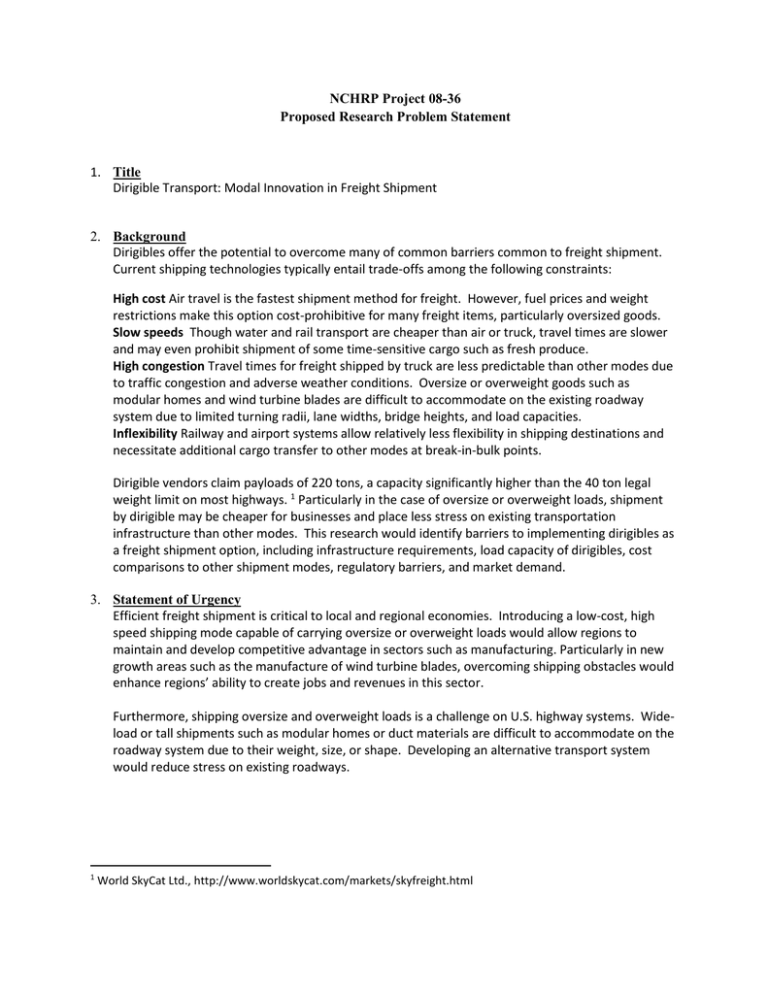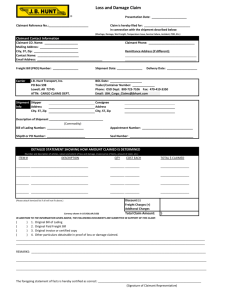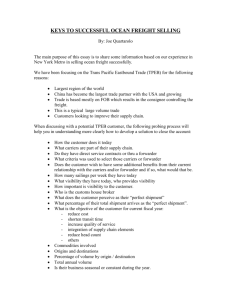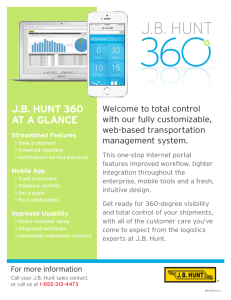Dirigible 08-36 app - American Association of State Highway
advertisement

NCHRP Project 08-36 Proposed Research Problem Statement 1. Title Dirigible Transport: Modal Innovation in Freight Shipment 2. Background Dirigibles offer the potential to overcome many of common barriers common to freight shipment. Current shipping technologies typically entail trade-offs among the following constraints: High cost Air travel is the fastest shipment method for freight. However, fuel prices and weight restrictions make this option cost-prohibitive for many freight items, particularly oversized goods. Slow speeds Though water and rail transport are cheaper than air or truck, travel times are slower and may even prohibit shipment of some time-sensitive cargo such as fresh produce. High congestion Travel times for freight shipped by truck are less predictable than other modes due to traffic congestion and adverse weather conditions. Oversize or overweight goods such as modular homes and wind turbine blades are difficult to accommodate on the existing roadway system due to limited turning radii, lane widths, bridge heights, and load capacities. Inflexibility Railway and airport systems allow relatively less flexibility in shipping destinations and necessitate additional cargo transfer to other modes at break-in-bulk points. Dirigible vendors claim payloads of 220 tons, a capacity significantly higher than the 40 ton legal weight limit on most highways. 1 Particularly in the case of oversize or overweight loads, shipment by dirigible may be cheaper for businesses and place less stress on existing transportation infrastructure than other modes. This research would identify barriers to implementing dirigibles as a freight shipment option, including infrastructure requirements, load capacity of dirigibles, cost comparisons to other shipment modes, regulatory barriers, and market demand. 3. Statement of Urgency Efficient freight shipment is critical to local and regional economies. Introducing a low-cost, high speed shipping mode capable of carrying oversize or overweight loads would allow regions to maintain and develop competitive advantage in sectors such as manufacturing. Particularly in new growth areas such as the manufacture of wind turbine blades, overcoming shipping obstacles would enhance regions’ ability to create jobs and revenues in this sector. Furthermore, shipping oversize and overweight loads is a challenge on U.S. highway systems. Wideload or tall shipments such as modular homes or duct materials are difficult to accommodate on the roadway system due to their weight, size, or shape. Developing an alternative transport system would reduce stress on existing roadways. 1 World SkyCat Ltd., http://www.worldskycat.com/markets/skyfreight.html 4. Project Objective(s) This research would explore the status of dirigible technology and produce a state of technology report. Research would identify barriers to implementing dirigibles as a freight shipment option, including ground infrastructure requirements, regulatory barriers related to air travel, routing considerations such as minimum and maximum flying altitude, and load constraints particular to this mode. The research would also identify a list of potential freight items for which dirigible transport may offer significant economic advantage. Finally, this research would produce principles of deployment outlining key requirements for consideration in implementing a dirigible transport system. 5. Relationship to Existing Body of Knowledge This problem statement proposal seeks to update the comprehensive understanding of the utility of dirigibles. C.J. Huang, et. al. conducted a systems engineering study of airships in 1976.2 The study demonstrated the feasibility of cargo shipment by airship and considered social, legal, environmental, and political factors to their implementation. This study is now over 30 years old; a literature search did not produce more recent analyses of the state of this technology. While previous dirigible research has explored dirigible prototypes and made preliminary economic assessments of this shipment mode, little of this research has been focused in the United States or on niche cargo applications. 3 This research problem statement would produce a more in-depth study of dirigibles’ potential related to shipping origins and destinations across U.S. regions. Furthermore, it would develop principles of deployment that would be applicable in these contexts. 6. List of Anticipated Work Tasks Interviews among dirigible manufacturers and vendors Interviews among potential customers for freight shipment Interviews among likely break-in-bulk points such as ports and airports Interviews among Federal Aviation Administration officials Cost/benefit comparisons between dirigibles and other shipping modes Final research report 7. Estimate of Funds Needed $94,000 8. Estimate of Time Needed to Complete the Research 9 months 2 Huang, C.J., et. al. “Cargo transportation by airships: a systems study,” Houston University, 1976 Prentice, Barry E., et. al. “The rebirth of airships,” Journal of the Transportation Research Forum 44, no. 1 (2005): 173-90 3 9. Name, Affiliation and Contact Information of Submitter(s) Mukhtar Thakur Office of Multimodal Innovation 395 John Ireland Blvd. St. Paul, MN 55155 Mukhtar.thakur@state.mn.us 651.366.4691 Fay Cleaveland Office of Transit 395 John Ireland Blvd. St. Paul, MN 55155 Fay.cleaveland@state.mn.us 651.366.4194 10. Date of Submittal 10.1.10


